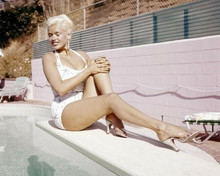In 1956, Jayne Mansfield stood at the peak of her fame, dazzling audiences and the media alike with her radiant beauty, magnetic charm, and irresistible screen presence. With her platinum blonde hair, hourglass figure, and signature pout, she embodied the glitz and allure of Hollywood’s golden age. Yet Mansfield was more than just a pretty face—she was a performer who wielded her image with intelligence, using her blend of sensuality and comedic timing to carve out a unique space in the entertainment industry.

A striking photograph taken by Ernest Reshovsky that year perfectly captures the essence of Mansfield’s appeal. In it, she appears poised yet playful, elegant yet bold. The image is not merely a portrait of physical beauty—it’s a snapshot of charisma, confidence, and a star fully aware of her power. At a time when female icons were often tightly controlled by studio expectations, Mansfield managed to project a carefully curated image that combined glamour with wit.

Often dubbed the “poor man’s Marilyn Monroe” by the press, Mansfield was frequently compared to the more established screen siren. However, this comparison underestimated her distinct talent. Where Monroe leaned toward vulnerability, Mansfield embraced outrageous confidence. Her performances in films such as The Girl Can’t Help It (1956) and Will Success Spoil Rock Hunter? (1957) showcased her comedic instincts and her ability to parody the very bombshell image she was known for.

In The Girl Can’t Help It, Mansfield played Jerri Jordan, a woman whose curvaceous figure launches a floundering singer into stardom—an ironic and self-aware role that mirrored Mansfield’s real-life ascent. Her role in Will Success Spoil Rock Hunter? further demonstrated her self-parodying abilities and helped cement her as more than just a sex symbol. These roles allowed Mansfield to push against Hollywood’s boundaries for female stars, challenging the notion that beauty and brains were mutually exclusive.
Mansfield’s influence went far beyond her roles on screen. She became a cultural sensation, with her every move followed by the press. She was a staple of magazine covers, talk shows, and tabloid headlines. Her flamboyant lifestyle—complete with a pink-themed mansion famously dubbed the “Pink Palace”—fueled her image as a larger-than-life figure. In an era fascinated by excess and fame, Jayne Mansfield gave the public exactly what they wanted, but always on her own terms.

Despite the public spectacle, Mansfield’s personal life was complex and often troubled. She married three times and had five children, including actress Mariska Hargitay. She juggled motherhood with a demanding career, all while navigating the pressures of stardom. Behind the dazzling façade was a woman who, like many of her contemporaries, faced the limits of a male-dominated industry. Studios often typecast her, and critics were slow to recognize her range. Still, she remained undeterred, continuing to work in film, television, and theater throughout the late 1950s and early 1960s.

The photograph by Ernest Reshovsky now serves as a timeless reminder of Mansfield’s unique contribution to Hollywood. It captures not only a woman at the height of her fame, but also the spirit of an era where image and reality danced together on the silver screen. Jayne Mansfield was a master of that dance, using her public persona as both armor and art.

Though her life was tragically cut short in a car accident in 1967 at the age of 34, Mansfield’s legacy endures. She remains a cultural icon, not only for her beauty and charisma but for her ability to challenge expectations and control her own narrative. Her films continue to be watched and studied, and her image—bold, glamorous, and unforgettable—still resonates today.

Jayne Mansfield in 1956 was more than a symbol of Hollywood glamour. She was a pioneer in the performance of celebrity, a woman who used her allure to entertain, provoke, and endure. And thanks to images like Reshovsky’s, her presence remains as captivating as ever—an eternal star of a golden age that still inspires admiration and intrigue.